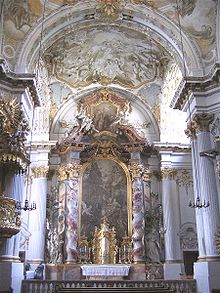This is an old revision of this page, as edited by Dusselmann (talk | contribs) at 19:39, 12 April 2010 (←Created page with 'thumb|St. Anna thumb|Entry to the church [[File:Damenstiftskirche Muenchen-1.jpg|thum...'). The present address (URL) is a permanent link to this revision, which may differ significantly from the current revision.
Revision as of 19:39, 12 April 2010 by Dusselmann (talk | contribs) (←Created page with 'thumb|St. Anna thumb|Entry to the church [[File:Damenstiftskirche Muenchen-1.jpg|thum...')(diff) ← Previous revision | Latest revision (diff) | Newer revision → (diff)


1440 Duke Albrecht III of Bavaria-Munich built a chapel at the house of the Indersdorfer monastic community in Altheim, an independent village in the area of today's street "Altheimer Eck". This chapel was replaced by the Gothic building, built to plans by Luke Rottaler and was inaugurated in 1496.
After 1732, work began on a new building for this Gothic church. Elector Karl Albrecht, who later became Emperor Charles VII, 1733 layed the foundation stone for the new Church (of "Salesianerinnen"). A monastery in the legal form of a chapter of nuns was set up. The architect was Johann Baptist Gunetzrhainer. The Asam brothers were responsible for the Interior. The women's collegiate church was consecrated in 1735.
The women's collegiate church was destroyed during the Second World War. In 1980, the reconstruction was made by Erwin Schleich. Because they did not want to use wrong colors for the ceiling fresco and only b/w photos were available, they decided on black and white paintings on the ceiling. Similarly, the three large altar-pieces have been implemented. Uncommon in Bavaria is also the figurative representation of the Last Supper.
The former convent itself was founded by Princess Maria Anna for nobility, is now a secondary school. The number of canons was set at ten noble lady. An age of 15 years and a record of 16 ancestors was a precondition for inclusion in the specially built foundation and residential buildings. Elector Maximilian IV Joseph changed the statutes and the ladies of ten to 18. Meanwhile, the Bavarian King Maximilian IV Joseph decided that now excellent women and fallen officers should be considered (May 6th, 1809). Thus, the bonuses were lower and the entry age was lowered to twelve years. Later, the ladies' figure was increased to 25 (great gift) and 48 (small gift).
External links
| This article has not been added to any content categories. Please help out by adding categories to it so that it can be listed with similar articles. (April 2010) |